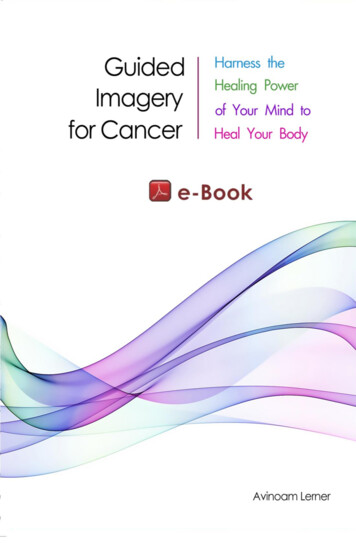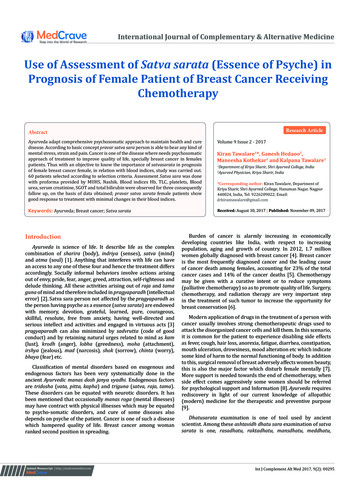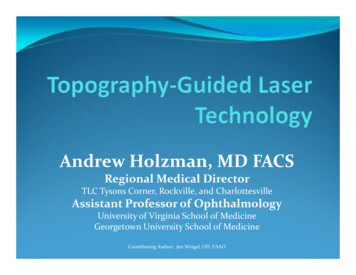
Transcription
1GuidedImageryfor CancerHarness the power of yourMind to heal your BodyBy Avinoam Lerner 2015 Avinoam Lerner. All Rights Reserved
2 2015, Avinoam LernerALL RIGHTS RESERVED. This book contains material protectedunder International and Federal Copyright Laws and Treaties.Any unauthorized reprint or use of this material is prohibited.No part of this book may be reproduced or transmitted in anyform or by any means, electronic or mechanical, includingphotocopying, recording, or by any information storage andretrieval system without express written permission from theauthor / AvinoamLerner.comFree@AvinoamLerner.com 2015 Avinoam Lerner. All Rights ReservedPrinted in Charlestown, NC
3Table of ContentsLegal Disclaimer . 7Get Immediate Access. Register at .Missingwww.AvinoamLerner.com/guided .MissingWhat is Guided Imagery? . 9Who Can Benefit from Guided Imagery?. 28Getting Started . Error! Bookmark not defined.Tips for best results .MissingCDs and Scripts: .MissingThe Successful Surgery .MissingScript: Successful Preparation for Surgery .MissingScript: Successful Recovery from Surgery .MissingSuccessful Chemotherapy CD .MissingScript: Successful Chemotherapy Track 1 .MissingSuccessful Sleep CD .MissingScript: Successful Sleep Script .MissingThe Healing Power of Your Mind .MissingScript: Immune Enhancement (Track 2) .MissingWhere Did It All Begin? .Missing 2015 Avinoam Lerner. All Rights Reserved
4How Is Guided Imagery Utilized in Cancer Care? .MissingHow Can Guided Imagery Benefit Cancer Patients?. 34What Research Has Been Done on Guided Imagery?.MissingHow to Put Everything Into Practice . 41About the Author . 45References . 48 2015 Avinoam Lerner. All Rights Reserved
5 2015 Avinoam Lerner. All Rights Reserved
6 2015 Avinoam Lerner. All Rights Reserved
7Legal DisclaimerWhile Guided Imagery or any other methods ofconditioning i.e. Creative Visualization, Visual Imagery,NeuroLinguistic Programming has many beneficial effects,cannot and will not substitute any current or futureprofessional medical or psychological care or treatment, andif any concerns i.e. medical or psychological arise, youshould first consult a qualified health care provider fordiagnosis, advice and care.Guided Imagery or any of the scripts or productsoffered in this book is not intended to diagnose, treat, curenor prevent any disease or illness. Never listen to GuidedImagery or self-conditioning recordings while driving a car oroperating machinery. It is your sole responsibility to alwayschoose an environment that is quiet and safe.Avinoam Lerner makes no claims to how soonchanges can occur or their permanency. His scripts, audiorecordings, suggestions and instructions are intended for thepurpose of self-help and personal use. Avinoam is a certifiedhypnotherapist, not a licensed physician nor licensed mental 2015 Avinoam Lerner. All Rights Reserved
8health professional nor a psychologist. He does claim toprovide any form of health care or psychotherapy and doesnot represent his services as any form of medical, behavioralor mental health care.Please consult your health care provider before making anyhealth care decisions or for guidance about a specificmedical condition. 2015 Avinoam Lerner. All Rights Reserved
9What is Guided Imagery?Guided imagery is the process of focusing the mindby engaging the creative faculty we call imagination. Itutilizes our ability to create mental visions and images andproject them onto the screen of our mind’s eye. We are allendued with this ability whether we are aware of it or not it is as simple as day dreaming or calling forth a memoryfrom long ago.Usingguidedimagery,wecanexploretherelationship between that which we hold in our mind andthat which we experience in the body and utilize, this mindbody connection, for healing and recovery.You may already have some experience with GuidedImagery or at the very least heard about its many benefits inhealthcare. It might be something that you stumbled uponwhile doing your research online, something a friend orfamily member mentioned or even something that yourdoctor recommended as a way to improve the quality of lifebetween visits. 2015 Avinoam Lerner. All Rights Reserved
10Over the past few decades Guided Imagery hasgained a solid reputation and there is a lot of information (aswell as misinformation) out there on the topic. This is why itis vital that before you get started with this book suggestedscripts, that you’ll understand exactly what it is and why it issuch a valuable tool in cancer care. If you are not excitedyet about the many benefits Guided Imagery offers youcertainly will by the end of this booklet; because regardlessof whether or not you believe it will work it will work! Thereason I know that is because you have been practicingGuided Imagery for many years. Yes, you have!The most common use of Guided Imagery, or shouldI say misuse of Guided Imagery is Worry, yes worry and ifyou are human you have done much of that already.Think for a moment about the practice of WORRY.When you worry you engage your imagination in things thathave not happened yet. They have not happened and maynever happen and still your mind is generating scenarios,most if not all are negative and based in fear. Now, whenyou worry, do you feel good? Is it pleasant? Of course not, 2015 Avinoam Lerner. All Rights Reserved
11nevertheless you engage in it because you feel threatenedand have legitimate concerns.In this booklet I will show you how to engage thesame mental faculties you do when you worry but in ahealthy way, a way that will promote a sense of wellbeingand comfort rather than fear and discomfort. All you need isan open mind and the willingness to follow my guidance. Ifyou will, you will certainly benefit from this practice in thesame way every other person in my care have.Guided Imagery is similar in many ways todaydreaming but the difference will be that Guided Imageryis structured and has a specific goal. The Thesaurus ofPsychological Index Terms officially defines Guided Imageryas a “mind-body technique involving the deliberateprompting of mental images, used in the treatment ofmental disorders, for performance enhancement, and inhelping patients cope with diseases and their symptoms”(2001). That may sound vague but, in practice, it is not sodifferent from the basic act of imagining which we all doevery day. 2015 Avinoam Lerner. All Rights Reserved
12For a few brief moments each day, we all loseourselves in our thoughts. You might be at work or lying inbed and suddenly find your mind has transported yousomewhere else. Suddenly, you are no longer aware of yourphysical surroundings. Your brain has taken you somewherefar away and you hadn’t even realized that it washappening. It can happen when we are worrying aboutsomething or looking back on a fond memory.Like so many other innate tools, we can use ourminds and thoughts to create positive experiences ornegative ones. We can lift ourselves out of a mundaneexperience or we can drown ourselves in the concerns ofdaily life. It is truly but a choice for each and every one ofus. It may not always feel this way but it is true, and while itmight feel like our circumstances have created our states ofmind, in reality, it is the other way around.Every person has his or her own unique journey inlife and we will all face a vast array of challenges, illness andcancer is but one of them. These challenges in and ofthemselves do not define us. What will define us is how we 2015 Avinoam Lerner. All Rights Reserved
13choose to look at these challenges. While cancer is a majorobstacle and undoubtedly has many negative connotations,we can still choose how to view and experience it. We canmake the best of it or we can allow it suffocate us. GuidedImagery seeks to teach its practitioners how to release theirminds from the grip of stress, anxiety and fear that burdenour minds and inhibit the healing capacity of our bodies.As I have said, you can think of Guided Imagery assimilar to daydreaming but there are many importantdifferences. We know how to daydream from childhood butmost of us never really learn to harness the spectacularpower of our imaginations. Our minds can truly accomplishimpressive feats and it is important to learn how to use thisincredible instrument.You wouldn’t begin driving a car without reading aninstruction booklet first and I believe that we can look at ourimaginations in a similar way. Our minds have so manydifferent facets that even hundreds of years of scientificstudy has not yet given us a complete picture of how it allworks. Guided Imagery gives us a small piece of the manual 2015 Avinoam Lerner. All Rights Reserved
14that we need to begin using our brains to their fullestpotential.One thing that makes Guided Imagery distinct fromdaydreaming is the direction that you receive through thenarration. In this Guided Imagery for Cancer program, weaim to teach you where to direct your thoughts and how touse them productively. Now, if you simply tell yourself tojust think of something positive, you often get lost inthoughts. This happened to me all the time before I beganusing Guided Imagery. I would be in a stressful situation andjust tell myself to think about something positive. It was agreat idea, in theory, but it was never effective for me. Itwould not last. It was only once I learned how to harness thepower of imagery that I could actually stop dwelling on thenegative things that were cluttering my mind.To use imagery productively, you need someguidance. You need to learn how to let go off your negativeemotions and focus your brain before you can realize all ofthe profound effects of Guided Imagery. One of the greatthings about it is that, after practicing Guided Imagery, you 2015 Avinoam Lerner. All Rights Reserved
15will be able to use it anytime, anywhere and withoutguidance. You will not need to get into a quiet room or useany other stereotypical aspect of meditation. After somepractice, it will simply become second nature to you.Guided Imagery has been described as “a gentle ation” (Naparstek, 1994). As your guide, my goal is toteach you exactly where and how to direct your imagination.We are all unique and therefore relax in different ways. Mygoal is to help you find your best way to relax. You don’tneed to be creative or have a vivid imagination, you simplyneed to make an effort and have a true desire to allow yourmind and body to relax.“We can change the whole world just byaltering the way in which we perceive it. “Avinoam LernerThe power of our minds never ceases to amaze me.We can change the whole world just by altering the way inwhich we perceive it. If you are dreading walking outside ona cold day, you can make yourself shiver just by picturing the 2015 Avinoam Lerner. All Rights Reserved
16icy air hitting your face. On the same chilly day, if you recallthe last time that you were lying on the beach relaxingunder the sun, you might find yourself warming up andforgetting about the cold for a moment. Our brain is aprofoundly potent tool. We can use it to worry about thingsthat may never happen or allow ourselves to be soothed bywonderful experiences that we may never have.Before you begin practicing the scripts included inthis booklet or listening to any audio or even the CDsincluded in my Guided Imagery for Cancer program, I wouldlike you to try this very quick exercise of your imagination. Itwill help you experience first hand the power of your ownmind and imagination.Look at a picture of a lemon, any lemon. It doesn’tmatter if it’s an actual lemon you got you’re your kitchen orjust a picture you found online or in a cooking book, justspend a moment looking at it and try to notice if it affectsyou in any way. there may not be much of a reaction andthat’s ok. If there is simply take a mental note of it and howintense or real it may feel. 2015 Avinoam Lerner. All Rights Reserved
17Now let’s try to do the same thing but this timewe’re going to involve our imagination. First, read the nextfew lines so you’ll know what you need to do. Then, closeyour eyes and imagine that you are holding a ripe and juicysour lemon in your hand allow the lemon to become realto you in all of its dimensions and in your mind’s eye, see itsbright color smell its citric scent, and even feel its weight inyour hand, how heavy with juice this slice is. When youhave, imagine that you cut that lemon in half, making sureto not get the juice all over your shirt and gently bring thathalf a lemon toward your mouth. As you do that, imaginethat you open your mouth wide and squeeze all that soursour lemon juice right into your mouth feel the juice pouronto your tongue feel the lemon juice surround yourtongue and begin pooling up inside of your mouth. Give thesour juice a good swish so you can savour the stingy tasteand notice what is taking place within and around yourmouth.Done correctly, it is likely that you have felt somekind of tingling sensation in your mouth, perhaps evensalivation; this is very normal and even expected. If you have 2015 Avinoam Lerner. All Rights Reserved
18not, do not despair, some people really like lemon juice andtherefore the experience is different. Simply try the sameexercise but this time with a very sour pickle. Imagineyourself biting into that sour pickle etc.This imagery exercise demonstrates the power ofyour imagination. When we just looked at the image of thelemon we only engaged one of our senses (sight), we werenot truly involved with what we gazed upon. To fully engagewith the lemon we need to utilize multiple senses, sight,taste, smell etc. This is the power of imagery and ourimagination.Think about the difference between chatting with afriend online or by telephone and actually seeing them inperson. When we send messages online, we are only usingour eyes. You may be able to recall what your friend wroteto you but you won’t be able to create the same vividmemories that you can when you actually see a person. Itcan be a bit more engaging to talk on the phone but it oftenstill feels like something is missing. 2015 Avinoam Lerner. All Rights Reserved
19When we are physically together with people, all ofour senses are engaged in the activity. Even the simple actof sitting at a table with a person whom we see every dayengrosses our bodies. You can see the person, feel the chairunderneath you, and smell the air around you. Every aspectof the experience will influence how you perceive theinteraction. If there is a sweet smell in the air, you mightfind a dull conversation more enjoyable. If the chair isuncomfortable, you might quickly tire of experience.It is rare that we realize it on a conscious level butour senses are working together all of the time. Our body isconstantly taking in new sensations and sending messagesto our brain. This interaction between our mind and bodycreates a profound impact on the way in which we perceiveeverything and everyone around us.When we are talking about Guided Imagery, it iscritical to remember the importance of using each one ofyour senses. Some people consider the idea of things likemeditation or Guided Imagery to be dull because they justenvision themselves sitting in a room doing nothing. While 2015 Avinoam Lerner. All Rights Reserved
20it may be true that your physical body is doing nothing, yourmind is being extremely active. If you think back to thetimes that you have spent daydreaming, you know that youdon’t have to physically do anything to feel like you arebeing active.Remember back to a time when you were trulyexcited about something. When we think about somethingthat we are looking forward to, we are fully engaged in ourthoughts. There is nothing boring about just sitting still andpicturing what it is that we are craving, especially when weenvision ourselves thriving with health and vitality.Incontrast, when we misuse Imagery as in the case of worryand anxiety they consume us.When we are using ourmental capacity to dread something, it can exhaust us.It is tiring to us not just mentally but also physically.If you are stressed for a long period of time, your bodymight start to feel like it is barely dragging along.This relationship between our body and mind isnothing short of spectacular. When we look at our favoritefood, we can almost taste it.When we recall a fond 2015 Avinoam Lerner. All Rights Reserved
21embrace, it is as if we can actually feel it. When we smellcertain scents, we feel like we have been transportedthough time.Do you remember the lemon/pickle exercise andhow it made your body react? This is one of the amazingtricks performed by our body that has prompted researchersaround the world to really take a close look at GuidedImagery.When we sense our salivation over the mentalimagery of the lemon, we realize that our imaginationaffects more than our mind, it affects our body.Thephysiological response shows that we can use mentalimagery to create very real responses in our bodies. Havingsaid that, we of course do not need to practice GuidedImagery for our bodies to create the physical response, itdoes it all by itself. All we are aiming to do is to tap into thisremarkable relationship between thoughts, imagination andthe physical body to improve our experience and ability torecover. 2015 Avinoam Lerner. All Rights Reserved
22The best part about this fascinating mental power ofimagination is that we can harness this ability to do far morethan just make ourselves drool. We can promote certainmental experiences that will lead to true physical changes. Itmay sound too good to be true but it is every bit real andimply amazing.Guided Imagery is based around this simpleprinciple. If we are able to create physical changes with ourminds, why not use our minds to make ourselves healthierand happier? We may not be able to fix everything just bythinking blissful thoughts but we can definitely have apositive impact.If you create harmony and happinesswithin your mind, your body will grow stronger and betterbe able to face the challenges of life. Let me be very clear,Guided Imagery is not wishful thinking; it has a real scientificfoundation that has been established through decades ofresearch.With practice, all of us can learn to make healthierand more resilient “blue prints” for our brains. We cancreate memories of times when are bodies and minds are 2015 Avinoam Lerner. All Rights Reserved
23engaged in something that they truly love. It doesn’t matterif we look back on positive experiences that we have had orif we just think up some new ideas that make us happy.Often when we are facing the unknown realm ofillness, fear sets in and we activate the fight-or-flight modethat wears our bodies down quickly. When faced with longterm stress, our bodies begin to feel like they areperpetually in this fight-or-flight mode. It impacts us bothphysically and emotionally.This physical response waslifesaving to our ancestors. It enabled them to react quicklyto dangerous situations and was an extremely powerful tool.In modern life, when we are rarely in a life or deathsituation, our brain still acts by constantly being in the “ON”mode when we encounter stress and this is where our newand improved “blue prints” can come in handy. Once wecreate our blue prints, we can use them anytime that weneed them.With some guidance and practice, anyone can learnto transition from having basic daydreams into using GuidedImagery productively. You may have heard advice before on 2015 Avinoam Lerner. All Rights Reserved
24the value of recalling positive memories when you are understress. You often see people with photos on their desks orimages on their computers of vacations, family members, orjust relaxing scenes. They do this, of course, because itreminds them of happy times in their lives. It is a great wayto deal with the stress of work or just relax whenever youneed it.It is not enough, however, to just look at aphotograph. If you remember my previous example of thelemon or pickle, you know that a two-dimensional photo isjust not enough to really transport a person.To trulychange your state of mind, you need to use more than justyour eyes. Your entire Self needs to be transported to adifferent place.If you have a fond memory of yourself lying on thebeach and want to use it as a tool for relaxation, you need torecall all of the sensations associated with it. You need tofeel the sun on your skin, smell the scent of salt in the air,and taste a fresh sip of lemonade circling around yourtongue. The more present your body is in this memory, the 2015 Avinoam Lerner. All Rights Reserved
25less aware you will be of the present moment and itsstressors. In basic terms, this is the foundation of GuidedImagery. It helps you to take your mind to a peaceful placethat allows the entirety of your body to relax and feel atease.The objective of Guided Imagery is to teach you howto create these positive states of mind and use themproductively. Stress is negative to our minds as well as ourbodies. By relaxing your mind, you feel better in the shortterm while facilitating your body’s natural ability to fightillness in the long run. And, of course, even if we can’t havehealthy bodies at every moment, we can have healthyminds. One of the goals of Guided Imagery is keep yourmind at the peak of health.Like most things in life, Guided Imagery becomeseasier with practice.You may be a bit tense andapprehensive the first time you work through a program buteach time it will get progressively easier and feel morenatural. It is really so simple that you may feel like you are 2015 Avinoam Lerner. All Rights Reserved
26doing something incorrectly. We have been so conditionedto believe that true reward only comes after struggle butthat is simply not always the case.With Guided Imagery, you will find your greatestrewards come after you give up your desire to struggle.When you allow your mind to be at peace, your body willbegin to relax and it will radiate through the entirely of yourbeing. All you need to do is follow the simple instructions ofthe narration and permit your mind to drift away.When you let go of the tension that you have beencarrying, you will find that you feel lighter. A burden will liftfrom your shoulders. While you can only realize this on acognitive level, your body will also realize it on a physicallevel. As you begin to feel more at peace internally, yourbody will react to and be able to function more productively.Once you have created your new and improvedmental blueprint and have a favorite “place” to go to in yourmind, Guided Imagery will become second nature. You willno longer need to sit down at home with your CD or MP3 2015 Avinoam Lerner. All Rights Reserved
27player. Your mind will be able to recall the path that it tookin the past to achieve contentment.Once your blueprint is readily available to you, youwill be able to harness a great level of power. Wheneveryou are feeling overwhelmed or just down, you can take outyour blueprint and allow your worries to drift away. Thebest thing about this is that you can do it anywhere at anytime. There is no preparation to be done and you don’tneed any special tools. It is a gift that will forever be heldwithin your mind. 2015 Avinoam Lerner. All Rights Reserved
28Who Can Benefit from Guided Imagery?Guided Imagery is a great tool for anyone whowishes to take part in their own healing and care. One ofthe best things about it is that it can be used anywhere atany time. You don't need any special skills and it is notdifficult to learn how to do it. Everyone needs a bit ofpractice to truly use Guided Imagery productively but youwill quickly improve your skills with a bit of practice.While serious conditions merit medical care and theuse of medication, Guided Imagery is a wonderfulaccompaniment to it. It can help to lessen fear and anxiety,reduce severity of side effects, improve sleep and quality oflife and so much more.In cancer care, Guided Imagery can help patientsmentally prepare for medical procedures, as well as recoverfrom these procedures more rapidly. It can help strengthentheir emotional, spiritual and physical resilience andenhance their resolve to heal.Guided Imagery can also be great for those who aresupporting a friend or family member who has cancer. Even 2015 Avinoam Lerner. All Rights Reserved
29though they are perfectly healthy, it may start to feel likecancer is taking over their lives. It is easy to forget howstressful it is for our loved ones when we are facing a majorstruggle in our lives. When you are trying your best tosupport someone important in your life, you are alwaystrying to put your own concerns and needs at bay. GuidedImagery can be a major asset for managing anxiety anddepression for those going through cancer care as well asthe people in their lives.Major life changes also cause major changes to ourdaily routines. We often don’t realize how important themundane parts of everyday life are until we can no longerdo them. When we have days where we can’t go to work orgo for evening walks or whatever other things we used to doevery day, it is easy to become disheartened and anxious.When we are ill and spending extra time in bed or at home,feelings of sadness can creep up quickly. It can start to feellike we have too much time alone with our thoughts. Wecan start to feel sorry for ourselves or feel like we’redrowning in our thoughts. If you are feeling a bit of cabinfever or just need to clear your mind, Guided Imagery is a 2015 Avinoam Lerner. All Rights Reserved
30priceless tool. The idea of spending quiet time alone withyour thoughts might feel a bit intimidating but it reallyshould not be, especially once you have learned how to useimagery to guide your mind.Guided Imagery is much more than just aninstrument for relaxation. It can help people cope with painmanagement, overcome nausea, prepare for biopsies andtransplants and even spring our immune system into action.Now, rest assures that in order to benefit you don’t need tobe a creative person or have a strong imagination. Youdon’t need to be a relaxed person or have experience withmeditation. The only thing you absolutely need is a bit ofdedication. You don’t need to go to a retreat or spend hourslearning the skills of a monk. You just need to keep yourmind open to that which naturally arise within you, andkeep practicing it for a bit until something clicks with you. Itis not solely a mental exercise so it doesn’t matter if yourconcentration level isn’t great or if your attention span isshort. You only need to let go of yourself a little and allowyour entire body to give into your mind. You need however 2015 Avinoam Lerner. All Rights Reserved
31utilize your emotions and all of your sensations to embracethe experience.Even if you have tried other relaxation techniques inthe past to no avail, Guided Imagery might be right for you.Everything has a time and a place and there is no reason todespair if you have previously tried a relaxation method thatdidn’t work for you. It may not have been the right time inyour life to try it or you simply may not have been in theright mood that day. Every relaxation program is different.Meditation is different from Guided Imagery and,even within the category of Guided Imagery; there are manytypes and styles. It is simply a matter of finding the programthat is right for you. You would never try a potato then saythat vegetables aren’t for you just because you didn’t likethat potato . Of course, we know that there are manyways to prepare potatoes and that they certainly don’trepresent all vegetables.It’s therefore important toremember this idea and apply it to other areas of our lives.The bottom line is that everyone can practice GuidedImagery and benefit from it. Women and children tend to 2015 Avinoam Lerner. All Rights Reserved
32take to it more quickly but nearly anyone can use itproductively. Your education level, age, gender, race, andhealth are irrelevant. It’s a nature ability inherit in all of ourbrains.A fascinating study was recently done withcongenitally blind patients. Researchers found that not onlyare blind people able to have visual dreams but they are alsoable to use imagery. The study found that blind patientswere using their visual cortex to process the things that theyhad heard and touched. They used the information fromtheir other senses, such as sounds, textures, and smells, tocreate a visual image in their mind (Bertolo, 2005).One of the most interesting aspects of this study isthat means that we don’t need to every have experiencedsomething to imagine it. Even if we are not creative peopleor if we don’t have any idea what an actual experiencewould be like, we can image it. We can create images thatcan trick our brain into momentarily believing that we areactually havi
Guided Imagery or any of the scripts or products offered in this book is not intended to diagnose, treat, cure nor prevent any disease or illness. Never listen to Guided Imagery or self-conditioning recordings while driving a car or oper










